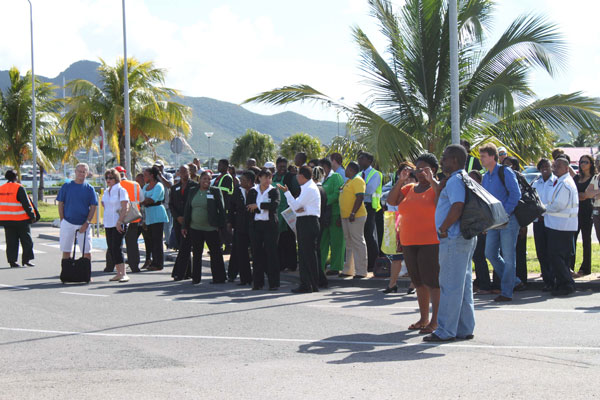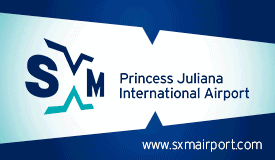 Simpson Bay:--- The Emergency Evacuation Drill at the Princess Juliana International Airport (PJIA) was seamlessly executed on November 22, 2011.
Simpson Bay:--- The Emergency Evacuation Drill at the Princess Juliana International Airport (PJIA) was seamlessly executed on November 22, 2011.This was the first time that the emergency evacuation drill was conducted by Princess Juliana International Airport Operating Company NV (PJIAE) at the terminal building since it was inaugurated in 2006.
The hour-long exercise called for the evacuation of all staff and management of PJIA and the businesses and services at the airport, along with all travelers and visitors to the airport from about 9:05 a.m.
Within minutes the building was mostly evacuated save for the handful of safety officers who stayed behind to "sweep" the building (last minute check for remaining people) and guide stragglers toward their designated exits and assembly points.
The evacuation drill was based on the scenario of a fire discovered in a mechanical room on level 2 of the four-level building.
In the scenario the airport would be at 70 percent occupancy at the time of the morning when the "fire" would have triggered the emergency event.
In reality, on Tuesday around 600 members of the airport community were present and all exited in a "speedy," "orderly" manner in which "nobody was panicking"— as described by the drill evaluators who gathered at the four assigned assembly points. The assembly points corresponded with the four corner areas of the airport building identifiable by green signage.
As the assembled calmly chatted, observed, stood or sat and waited at the four points, the PJIA managing director Regina LaBega, Manager of Operations Michel Hyman, Deputy Chief of Rescue & Fire Fighting Damian Cooks, and other key members of the evacuation drill workgroup team, continued to diligently network and monitor the progress of the emergency event and to attend to their pre-designated assignments.
The airport taxi drivers were also included in the drill, and were instructed to move their vehicles from the Arrival Lane and have them parked near the easterly assembly point facing the lagoon for the duration of the drill.
By 9:30 a.m., the initial 600 or so occupants and users of the airport were joined by a number of passengers who had arrived and, directed by security, filed into the assembly areas almost imperceptibly. Some of the waiting passengers appeared to be taking the drill as part of their St. Martin experience, observing, some casual, some alert, and some posing for the occasional reporter's camera, or taking pictures of fellow travelers.
Around 9:43 a.m. the occupants of the "PJIA community," as LaBega refers to the airport and all of its users, started walking back to the building, some in single file groups identified by the airline, shop, cleaning service or other companies that are tenants of the hub-busy international airport.
At 10 a.m., by all visible signs PJIA was back to normal.
At 10:06 a.m. the emergency evacuation team met in the training room at PJIA to evaluate the Emergency Evacuation Drill.
 Hyman opened the meeting by thanking the team. He called the evacuation "a success" and said that the purpose of the evaluation meeting was to determine the areas that needed to be improved, and as such, "build on what we have and to enhance the evacuation plan."
Hyman opened the meeting by thanking the team. He called the evacuation "a success" and said that the purpose of the evaluation meeting was to determine the areas that needed to be improved, and as such, "build on what we have and to enhance the evacuation plan."LaBega congratulated the entire team on the first drill. "You did a commendable job. The review of what took place is for us to be better in the event of a real disaster." We need to take "the evacuation extremely serious and I'm happy that you did," said LaBega
The review comments targeted personnel, equipment, building, and procedural glitches. One departing point that all agreed on was that the evacuation of the building, was "speedy" and "orderly."
The most impressive comments came from the keen-eyed officers of the Government Fire Department, who called the PJIA operations "impressive."
The fire officers stressed the importance of the critical need for the safety team that "sweeps" the building to ensure it is fully evacuated and then exit themselves.
Communication between the volunteer safety officers, security officers, and between the assembled groups and their group leaders will also be improved upon and streamlined as a result of the drill.
Most of the equipment such as automated doors and alarms, worked according to emergency procedures.
The sound alarm and the voice alerting all, that, "due to an emergency it is necessary to evacuate the terminal" remained clear and constant throughout the operation, although it was noted by evaluators that the alarm sound could be a bit louder at the onset of the emergency alert.
Overall, the emergency evacuation drill was deemed successful and PJIAE intends to conduct similar drills annually.
"We would like to thank all users of the airport for their participation and cooperation during the emergency evacuation drill," LaBega concluded.










